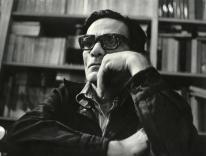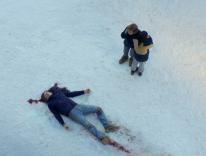Note to the reader: This review was written before the terrible accident that ended the life of Mike Tyson’s young daughter. I’m letting the piece stand as written, and I trust that nothing in it shows any insolence to a man who must currently be undergoing the greatest agony of his life.
One day in the late 1980s, I invited my father out for dinner or a movie, but he turned me down. “I have to catch a fight on TV. There’s this kid who’s supposed to be, uh...really something.” As I recall, that fight was the one in which heavyweight champion Michael Spinks was knocked out ninety seconds after the opening bell. The “really something” kid who did it was “Iron Mike” Tyson, twenty-two years old and already the most fearsome boxer on the face of the earth.
About a decade later, I was telling some Halloween stories to a bunch of fifth-graders. When I related how Rotten Jack (a character so obnoxious that Satan forbade him entrance into hell) once bit off a man’s ear in a barroom brawl and then ate it, a boy cried out, “Mike Tyson!” This was after the second Tyson-Holyfield fight, when a real ear had been chomped, making Tyson an ogre not only to children but also to sportswriters and most of the public.
Surely it is this reputation, not just for fierceness but for out-and-out monstrousness, that inspired James Toback to make a documentary about the fallen champion. In the 1960s, Toback, then a journalist, was a friend and protégé of Norman Mailer; and, like his old mentor, he is fascinated by the way men behave in physically dangerous situations. He knows well that the boxing ring is a place where a mask of viciousness can be as decisive as an uppercut. But where is the dividing line between controlled aggressiveness and uncontrolled brutishness? When does a gladiator turn into a thug? In Tyson, Toback seeks the roots of a boxer’s monstrous persona, not so much to deny it as to render our judgment of the man more complex. And up to a point he succeeds. (Tyson was one of the film’s executive producers, and probably participated in order to present himself as more “human.” I suspect Toback’s intentions were more mixed and more interesting.)
Like many documentaries, Tyson features new interviews that comment on old footage. The footage provides the storyline and the commentary wrests meaning from the story. Tyson is the only commentator, and this not only gives the film its peculiarly locked-in feeling but also marks off its emotional limits. Rather than a prismatic view of the man, we receive a sort of apologia (though hardly an apology).
The interviews are also as close as we are likely to get to a psychiatric session with the boxer. Toback, instead of positioning himself beside the camera, took a seat behind Tyson, as a psychiatrist sometimes does with a patient. The questions were then cut out, so that we wind up with a kind of monologue, but the fighter’s eyes keep sliding over to the right side of the screen—his understandable instinct is to look at his interlocutor. This makes Tyson come across as, by turns, vulnerable, guarded, pleading, and defensive. He often seems to be talking to a guardian angel perched on his shoulder or a tormenting little demon. The Maori tattoos on his face look more like age lines than symbols, but his eyes and voice are those of a pleading child. His Brooklyn accent and thick lisp amplify the pathos.
But if Talking Head Tyson is an ego in search of a superego, the young Tyson we see in the news clips is the id unfettered. After victories, he prances, leaps, gleefully rolls around on the canvas, taunts the defeated foe for “crying like a woman,” and challenges a heckler to a fight. The news footage, which has the reddish, slightly blurred look of badly preserved tape blown up for the big screen, suits the rawness of Tyson’s story. The sensitive Mike of the interviews and the boasting Mike of the news clips often share the screen. Toback has written that he sought “thematic complexity and multiple layers of character and behavior by splitting the screen into separate images.” The filmmaker’s technique gives Tyson vividness and propulsion, but how much actual psychological complexity emerges from the film?
The violence of the man, both in and out of the ring, is amply accounted for. A childhood on the streets of Brooklyn’s Brownsville neighborhood, a broken home, and hoodlum pals could easily have led the adolescent Tyson to prison. That they didn’t was partly due to the odd fact that, back then, he wasn’t physically formidable. A short, pudgy kid, bullied and mugged, he turned to boxing simply to defend himself. He showed promise and was taken under the wing of Cus D’Amato, the famous trainer of Muhammad Ali. In the old man, Tyson clearly found a father figure. D’Amato took the boy into his home and urged him to use his mind and to draw on spiritual reserves inside the ring. When D’Amato died just after Tyson became heavyweight champion, Tyson went haywire (his grieving remembrance of D’Amato is the most moving moment in the movie). His spiral downward included a fiasco of a marriage to actress Robin Givens, a failed—though less contentious—second marriage to the mother of his children, lousy business deals (some of them with the egregious Don King), ongoing promiscuity, drugs, drinking, and finally a rape charge that put him in prison for three years.
By that time, his life had become as dissolute inside the ring as it was outside. Knocking out second- and third-raters in the opening rounds didn’t develop Tyson’s staying power. When a lesser fighter, Buster Douglass, survived the initial rounds, Tyson lost his title to him, and his two matches with the first-rate Evander Holyfield were even worse. Holyfield demolished Tyson in the first bout; the ear-biting in the second virtually ended Mike’s career. Though there were post-prison fights, Tyson had lost the will to win.
The story holds us, but what about the man himself? There are certainly enough contradictions in him to pique our interest. He tells us that, once he was famous, he was thrilled to find women who made him feel he was interesting to talk to. Yet seduction for him was like a tiger’s watching its prey before the kill. He says he has a lot of love to give women, but he also says he doesn’t want to be loved. Acknowledging that ear-biting isn’t a worthy tactic for someone who considers himself the heir of Muhammad Ali, Tyson also tries to excuse himself by saying the biting was just a response to head-butting. As for the beating he gave Don King during a financial dispute, he at first wants to make us feel that it was King’s (indisputable) loathsomeness that provoked it, but then he also wants us to know that he must have blacked out before attacking King. So, does he feel he was wrong or not?
He tells us what a wonderful woman his second wife is (and what we see of her supports the claim). He admits that his philandering ruined their marriage. Yet he was no longer an itchy adolescent when he married her. He had already been in prison for the rape conviction that—whether it was, as he claims, a frame-up or not—came about because of his philandering.
Complexity of character is interesting, but Tyson’s avoidance of his own complexity became infuriating to this viewer. Yes, he and the director present us with multiple contradictions, but Tyson doesn’t really face them in any significant way. Perhaps he just lacks the verbal skills to do so, or perhaps the director couldn’t steer the interviews to a deeper level of self-awareness. Could this be why, late in the film, he has Iron Mike recite, of all things, the climactic stanzas of another ex-con’s poem, “The Ballad of Reading Gaol”—the lines about each man killing the thing he loves? And let it be said that this semi-educated man with a lisp reads Wilde’s words not only sincerely but with a sensitivity to pace and rhythm that would do credit to an actor. Still another contradiction!
So, does Tyson sustain the center of Tyson? Not quite. Though now well into his forties, somehow the man is still not old enough or wise enough to sum up the story of his life so far. Too many undigested offenses inflicted on him still choke him; too many wounds that he’s inflicted on others haven’t been truly regretted. For years he was dismissed as an unthinking brute. The surprise of this movie is that it reveals Tyson as a man who has reflected a great deal, but the thoughts haven’t fallen into place yet. The movie is as interesting and as unfulfilled as its hero.
Please email comments to [email protected] and join the conversation on our Facebook page.
Share
Previous Story
Bibi! Bibi!
Next Story
For Better & for Worse


